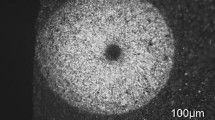Abstract
Fatigue cracks were propagated through carburized cases in M-50NiL (0.1 C,4 Mo, 4 Cr, 1.3 V, 3.5 Ni) and CBS-1000M (0.1 C, 4.5 Mo, 1 Cr, 0.5 V, 3 Ni) steels at constant stress intensity ranges, ΔK, and at a constant cyclic peak load. Residual compressive stresses of the order of 140 MPa (20 Ksi) were developed in the M-50NiL cases, and in tests carried out at constant ΔK values it was observed that the fatigue crack propagation rates,da/dN, slowed significantly. In some tests, at constant peak loads, cracks were stopped in regions with high compressive stresses. The residual stresses in the cases in CBS-1000M steel were predominantly tensile, probably because of the presence of high retained austenite contents, andda/dN was accelerated in these cases. The effects of residual stress on the fatigue crack propagation rates are interpreted in terms of a pinched clothespin model in which the residual stresses introduce an internal stress intensity, Ki where Ki, = σid 1/2i (σi = internal stress, di = characteristic distance associated with the internal stress distribution). The effective stress intensity becomes Ke = Ka + Ki where Ka is the applied stress intensity. Values of Ki were calculated as a function of distance from the surface using experimental measurements of σi and a value of di = 11 mm (0.43 inch). The resultant values of Ke were taken to be equivalent to effective ΔK values, andda/dN was determined at each point from experimental measurements of fatigue crack propagation obtained separately for the case and core materials. A reasonably good fit was obtained with data for crack growth at a constant ΔK and at a constant cyclic peak load. The carburized case depths were approximately 4 mm, and the possible effects associated with the propagation of short cracks were considered. The major effects were observed at crack lengths of about 2 mm, but the contributions of short crack phenomena were considered to be small in these experiments, since the two steels were at high strength levels, and short cracks would be expected to be of the order of 10 μm. Also, the two other steels behaved differently and in a way which followed the residual stress patterns. Both M-50NiL and CBS-1000M have a high fracture toughness, with Klc = 50 MPa · m1/2 (45 Ksi · in1/2), and the carburized cases exhibit excellent resistance to rolling contact fatigue. Thus, M-50NiL, carburized, may be useful for bearings where high tensile hoop stresses are developed, since fatigue cracks are slowed in the case by the residual compressive stresses, and fracture is resisted by the relatively tough core.
Similar content being viewed by others
References
J. A. Rescalvo and B. L. Averbach:Metall. Trans. A, 1979, vol. 10A, p. 1265.
B.L. Averbach:Metal Progress, December 1980, vol. 118, p. 19.
J.C. Clark:A1AA Journal Aircraft, 1975, vol. 12, no. 4.
M. E. Hilley, J. A. Larson, C. F. Jatczak, and R. E. Rickless: S.A.E. Publication J784a, August 1971.
C.F. Jatczak, J. A. Larson, and S.W. Shin: S.A.E. Publication SP-453, September 1979.
W. Elber: ASTM STP 486, American Society for Testing and Materials, Philadelphia, PA, 1971, pp. 230–42.
W. Elber:Eng. Fracture Mech., 1970, vol. 2, p. 37.
J.C. Newman:Behavior of Short Cracks in Airframe Components, AGARD Conf. Proc, AGARD, France, 1983, no. 328, pp. 6.1–6.26.
R. O. Ritchie:Advances in Fracture Research, S. R. Valluri, D. H. R. Taplin, P. Rama Rao, and J. F. Knott, eds., Sixth Int. Conf. on Fracture, Pergamon Press, 1984, pp. 235–60.
D. O. Harris and A. S. Tetelman:Eng. Fracture Mech., 1972, vol. 4, p. 93.
A. P. Parker: ASTM STP 776, American Society for Testing and Materials, Philadelphia, PA, 1982, pp. 13–31.
D. V. Nelson: ASTM STP 776, American Society for Testing and Materials, Philadelphia, PA, 1974, pp. 172–94.
W. Elber: ASTM STP 559, American Society for Testing and Materials, Philadelphia, PA, 1982, pp. 45–58.
C. Kim, D. E. Diesburg, and G. T. Eldis: ASTM STP 776, American Society for Testing and Materials, Philadelphia, PA, 1982, pp. 224–34.
I.C. Mayes and T. J. Baker:Metal Science, 1981, vol. 15, p. 320.
Author information
Authors and Affiliations
Rights and permissions
About this article
Cite this article
Averbach, B.L., Lou, B., Pearson, P.K. et al. Fatigue crack propagation in carburized high alloy bearing steels. Metall Trans A 16, 1253–1265 (1985). https://doi.org/10.1007/BF02670330
Received:
Issue Date:
DOI: https://doi.org/10.1007/BF02670330




